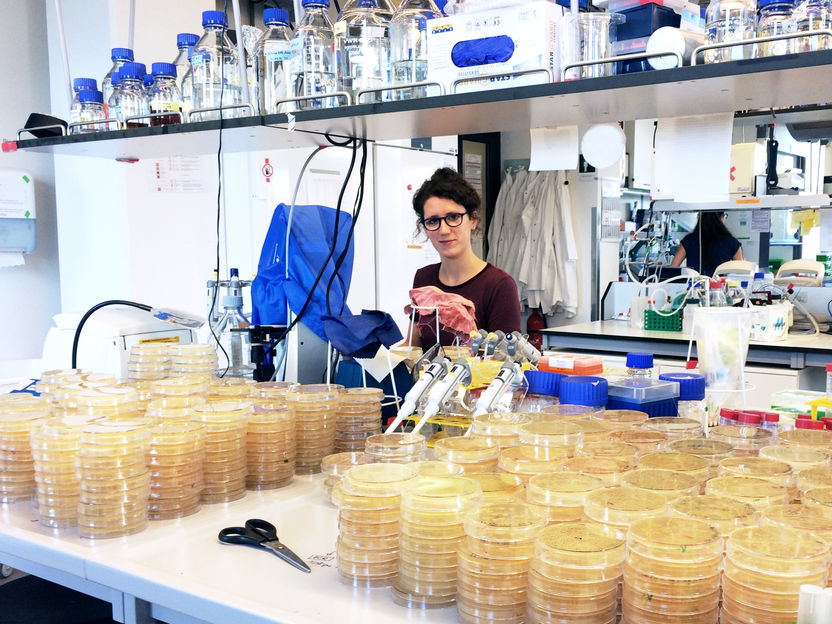New findings on the evolution of bacterial antibiotic resistance
Plasmids and bacterial cells do not always play in the same team
Advertisement
The genetic information of many microorganisms, especially bacteria, is partly available in so-called plasmids. These are genetic elements that consist of only a single DNA ring, are not present on the chromosomes and can multiply independently. Thanks to such plasmids, bacteria are able to transfer genetic information very quickly among themselves and also across the borders of different bacterial species. This process, known as horizontal gene transfer, is centrally involved in the evolution of microorganisms and helps them to adapt flexibly to changing environmental conditions. This rapid adaptability is a major advantage, especially for bacterial pathogens.

Dr Tanita Wein, the leading author of the study, has recently graduated her PhD and is currently working on her postdoctoral research in the research group of Prof. Rotem Sorek at the Weizmann Institute of Science in Israel.
© Institute of General Microbiology, Kiel University
Last year, a research team from the Institute of General Microbiology at Kiel University demonstrated that plasmids, as frequent carriers of resistance genes, can survive stably in bacterial cells permanently and without selective pressure. They can thus form a reservoir for the development of resistances, which can lead to the insensitivity of all later generations of bacteria to treatment even after a single administration of antibiotics. In a subsequent study, scientists from the Genomic Microbiology group led by Professor Tal Dagan have investigated the effect of antibiotic administration on the stability of the plasmids in the bacterial cells and thus their evolutionary success. They found that the presence of selective pressure exerted by the antibiotics does not always promote the stable plasmid inheritance - although they carry resistance genes that are beneficial for the cell.
Plasmids and bacterial cells do not always play in the same team
The ubiquitous occurrence of plasmids in nature initially suggests that plasmids develop stable heredity and remain in a population of bacteria in the long term - as long as they do not have a negative influence on the fitness of the host organism, for example through their energy requirements. The Kiel research team therefore investigated why, contrary to this assumption, plasmid stability does not occur in all cases, although the plasmids are beneficial under selection pressure. To this end, they cultivated the bacterium Escherichia coli in evolutionary experiments, both with and without antibiotic administration. This enabled them to investigate how the presence of the plasmids developed over the generations of bacteria. "In the presence of antibiotics, every bacterial cell must develop resistance, otherwise it dies. Therefore, all cells that have a plasmid as carrier of the resistance gene survive under these conditions," emphasizes first author Dr Tanita Wein, who recently graduated in Dagan's research group. "It does not matter to the bacterial cell what state the plasmid is in and both stable and unstable plasmid variants survive," Wein continues.
The plasmids have the tendency to form so-called multimers, i.e. to combine several individual plasmids to form a large coherent structure. When the bacterial cell subsequently divides, the large multimer with several resistance genes only passes into one daughter cell, but the second new cell does not receive any. Although the plasmid with its resistance genes, which is likely amplified by this process, is advantageous for the bacterial cell, it also becomes unstable - because without the selective pressure of an antibiotic the large multimer is lost again. In summary, this means that positive selection with regard to antibiotic resistance leads to the maintenance of sub-optimal plasmid variants that cannot be inherited in a stable manner in the long term.
These processes show that the bacterial cells and the plasmids have no common interest in the figurative sense. The evolutionary selection of their properties takes place at different levels and does not always serve the advantage of both parties involved, although they exist in a common organism. "In this specific case, this means that the advantage for the host cell mediated by the plasmid is accompanied by a reduced success for the evolution of the plasmids and that the interests of the plasmid and the cell are in this case contrary to each other. The view of plasmids as units that develop autonomously from their host cells therefore helps to better understand the course of their joint evolution," explained Wein.
Better understanding of resistance evolution
Overall, the new research results from Kiel University could lead to a better understanding of the hereditary processes in plasmids and the associated consequences for the host organism. "Our results suggest that rapidly changing conditions such as the alternating presence and absence of antibiotics rather than constant selection are the key to rapid adaptation of plasmids," Dagan emphasizes. "Our findings might therefore also be applicable to the processes that lead to the emergence of multi-drug resistance in pathogens," opines Dagan.

















































